Abstract
E2F transcription factors (E2Fs) are a family of transcription factors involved in cell proliferation, differentiation, and apoptosis. Their important roles in the development and metastasis of breast carcinoma (BC) have been discovered by previous in vitro and in vivo studies. Yet, expressions and distinct prognostic values of these eight E2Fs in human BC remain unclear in many respects. In this study, we aimed to reveal their roles in BC through analyzing the transcription and survival data of the E2Fs in BC patients from four online databases including ONCOMINE, Breast Cancer Gene-Expression Miner v4.1, cBioPortal for Cancer Genomics, and Kaplan–Meier Plotter. We found the overexpression of E2Fs in BC tissues compared with normal breast tissues, except for E2F4. Higher expression levels of E2Fs, except for E2F4 and E2F6, were associated with higher levels of Scarff–Bloom–Richardson grade of BC. Alterations of E2Fs were found to be significantly correlated with poorer overall survival of BC patients. Through plotting the survival curve in the Kaplan–Meier Plotter, it was found that higher mRNA levels of E2F1, E2F3, E2F7, and E2F8 were associated with poorer relapse-free survival in all BC patients, indicating that they are potential targets for individualized treatments of BC patients. Conversely, higher mRNA expression level of E2F4 predicted better RFS in BC patients, suggesting E2F4 as a new biomarker for BC prognosis. Considering currently available limited evidence, further studies need to be performed to investigate the roles of E2Fs in BC.
Introduction
The E2F transcription factors (E2Fs), which were discovered almost 30 years ago, have been confirmed to play significant roles in cell proliferation, differentiation, and apoptosis.Citation1 It is known that there are eight E2F family member genes so far, named E2F1–E2F8 in the order of discovery. The E2Fs came to the forefront of cancer research when they were found to be associated with and regulated by the RB protein, the product of gene mutation in retinoblastoma.Citation2 Cancer-related proliferative roles of E2Fs have been found in many kinds of human cancer, including breast carcinoma (BC). It was found that they regulated tumor development and metastasis in animal models of BC.Citation2,Citation3 These eight E2Fs, however, are supposed to have some specific functions and overlapping roles according to current studies.Citation4
BC, the most common malignant tumor among women in both developed and developing countries, remains one of the leading causes of cancer death among women worldwide.Citation5 BC is supposed to have diverse characteristics in pathology and molecular biology. BC subtypes defined by immunohistochemical expression of estrogen receptor (ER), progesterone receptor (PR), and HER2 provide prognostic values of BC patients.Citation6 In this molecular classification system, triple-negative BC (TNBC) has the worst overall survival (OS) and disease-free survival (DFS),Citation6 and the E2Fs have been implicated in regulation of TNBC.Citation7 Complex genetic mechanisms regulate and control the cell cycle in cancers, including amplification, mutation, and overexpression of the genes encoding the core components in the cell cycle.Citation8 These components include the cyclins, cyclin-dependent kinases (CDKs), CDK inhibitors, and RB1, all of which contribute to activation of the downstream E2Fs, and activation of E2Fs in turn causes unrestricted cell proliferation and divisions.Citation8 Mutations of the RB1 gene or components regulating the CDK-RB-E2F pathway have been identified in nearly all human malignant tumors, including BC.Citation8
The E2Fs, as mentioned before, are supposed to have complex and distinct roles in human BC. Several reports have discovered that amplification of the E2F1 or E2F3 gene locus and overexpression of E2F1 or E2F3 were frequent genetic events in many human malignancies, whereas large chromosomal deletions of regions including the E2F1, E2F2 or E2F3 genes have been detected in some cases.Citation9 The conclusions of current studies on the role of E2F4 are controversial regarding whether it was a suppressor or an activator of carcinogenesis. E2F4 seemed to be able to function as a tumor suppressor or an oncogene through regulating alternative sets of genes in different tissues.Citation9 An increased gene copy number of E2F5 was detected in two independent cohorts of BC patients.Citation10,Citation11 Evidence from several studies found that E2F6 negatively regulated BRCA1 in human cancer cells, functioning as a repressive transcription factor in a histone methyltransferase independent manner on target promoters.Citation12,Citation13 For BC patients receiving tamoxifen treatment, high expression level of E2F7 was associated with elevated risk of relapse and poor prognosis.Citation14 Up-regulation of E2F8 was reported to promote cell proliferation and tumorigenicity in BC by modulating the G1/S phase transition.Citation15 However, due to limited studies at present, the expression patterns, functions, and prognostic values of the E2Fs in human BC have not been clearly elucidated.
Microarray technology, which has developed rapidly during the past few years, has revolutionized DNA and RNA research and has become essential technology for biomedical research.Citation16 Based on comprehensive analysis of gene expression data and survival data published online, we performed this study to clarify and determine the distinct patterns of expression and significance for survival prognosis of eight E2Fs in BC patients.
Materials and methods
Ethics statement
This study was conducted in accordance with the principles of the Declaration of Helsinki, and with the approval from the academic committee of Sun Yat-sen University Cancer Center. All data were obtained from published online research, which undoubtedly contained informed consent.
ONCOMINE
ONCOMINE, a cancer microarray database and web-based data-mining platform,Citation17 was applied to analyze the mRNA levels of E2Fs in BC. We searched ONCOMINE (www.oncomine.org) for the fold changes of E2Fs in BC using the filters of differential analysis (cancer vs normal), cancer type (breast cancer), sample type (clinical specimen), data type (mRNA), and gene (E2F1, E2F2, E2F3, E2F4, E2F5, E2F6, E2F7, or E2F8). The comparisons of mRNA levels of E2Fs in BC and normal tissues in each individual dataset were conducted using the Student’s t-test. We then conducted the meta-analysis of differential expression of E2Fs in BC vs normal tissues. Random-effects models were employed in the meta-analysis according to the method previously described elsewhere.Citation18
The Breast Cancer Gene-Expression Miner v4.1
The Breast Cancer Gene-Expression Miner v4.1 (bcGenEx-Miner v4.1) is a statistical mining tool of 36 published annotated genomic datasets (total of 5,861 patients) and has three statistical analysis functions, as listed in the following paragraphs.Citation19,Citation20 The expression module permitted comparisons of expressions of candidate genes according to several clinical criteria, such as age, nodal status, ER status, PR status, HER2 status, and so on. The prognostic module evaluated the prognostic values of candidate genes in human BC and the correlation module permitted analysis of the correlations between candidate genes.
The cBioPortal for Cancer Genomics
The cBioPortal for Cancer Genomics provides visualization, analysis, and downloading of large-scale cancer genomics datasets.Citation21,Citation22 The breast cancer dataset (METABRIC, Nature 2012),Citation23 which contains data, including histopathological data of 2,509 BC patients, was chosen for analyses of E2Fs using the cBioPortal for Cancer Genomics (www.cbioportal.org). Selected genomic profiles included mutations, copy-number variance from GISTIC, and mRNA expression z scores (Illumina Human v3 micro- array) with a z score threshold of ±2.0. OS was calculated with the Kaplan–Meier survival curve according to the instruction on the website.
The Kaplan–Meier Plotter
The Kaplan–Meier Plotter (www.cbioportal.org),Citation24 which collected miRNA expression data and survival data of a total of 5,143 BC patients from gene expression omnibus (GEO) (http://www.ncbi.nlm.nih.gov/geo/), The Cancer Genome Atlas (TCGA) (http://cancergenome.nih.gov/), European Genome-phenome Archive (EGA) (https://ega.crg.eu/), and PubMed (http://www.pubmed.com),Citation25,Citation26 was used to explore the prognostic values of mRNA levels of E2Fs in BC. BC patients were divided into two groups by the median mRNA expression level (high expression vs low expression) in order to analyze the OS and relapse-free survival (RFS) with Kaplan–Meier plots, in which the number-at-risk was listed. Only the JetSet best probe set of E2Fs was selected for our analysis.Citation27 The HR with 95% CI and the log-rank P-value was calculated in each Kaplan–Meier survival plot and the cutoff of log-rank P-value was defined as 0.05.
Results
The transcription levels of E2Fs in BC compared with that in normal tissues
A total of 13 datasets containing 3,555 samples were included in this study, of which the largest two are the Curtis dataset (2,136 samples) and TCGA dataset (593 samples). The Curtis dataset collected breast cancer specimens from tumor banks in the UK and Canada,Citation28 while TCGA dataset was generated by the National Cancer Institute (NCI) in the USA. Through conducting meta-analysis based on the ONCOMINE data bases, we compared the transcription levels of eight E2Fs in BC and normal tissues (Tables S1–S8) We found that the mRNA expression levels of E2F1, E2F2, E2F3, E2F5, E2F6, E2F7, and E2F8 were significantly higher in BC tissues, with fold changes of 1.63, 2.07, 1.53, 1.61, 1.21, 2.27, and 2.05, respectively (). However, there was no significant difference between the transcription levels of E2F4 in BC and normal tissues (fold change =1.13, 95% CI: 0.87–1.40).
Table 1 Results of meta-analysis of differential expression of E2Fs in BC vs normal tissues (ONCOMINE)
The mRNA levels of E2Fs are correlated with clinical and molecular features of BC patients
The Welch’s tests, along with Dunnett-Tukey-Kramer’s tests for pairwise comparison when appropriate, were performed to compare the mRNA levels of E2Fs between groups of patients divided according to different clinical and molecular criteria in the bcGenExMiner v4.1. For the criterion of age, it was found that no significant difference existed between ≤51 years old and >51 years old groups of E2F1, E2F4, E2F7, and E2F8, whereas downregulated expression of E2F2, E2F3, E2F5, and E2F6 in the older group was found (). BC patients with positive nodal status showed higher mRNA level of E2F5 than negative nodal patients ().
Table 2 The correlation between mRNA levels of E2Fs and clinical and molecular criteria of BC patients
Higher Scarff Bloom & Richardson (SBR) grade status was found to be correlated with higher mRNA levels of all E2Fs (). For E2F4 and E2F6, although a significant difference was detected in the Welch’s test, the group comparison between SBR1 and SBR2 by Dunnett-Tukey-Kramer’s test of both did not show a significant difference (the cutoff value of P is 0.05) (Table S9).
Figure 1 The relationship between mRNA levels of E2Fs and SBR grade.
Notes: (A) E2F1 (204947_at). (B) E2F2 (228361_at). (C) E2F3 (203693_s_at). (D) E2F4 (202248_at). (E) E2F5 (221586_s_at). (F) E2F6 (203957_at). (G) E2F7 (228033_at). (H) E2F8 (219990_at).
Abbreviations: E2Fs, E2F transcription factors; SBR, Scarff Bloom & Richardson.
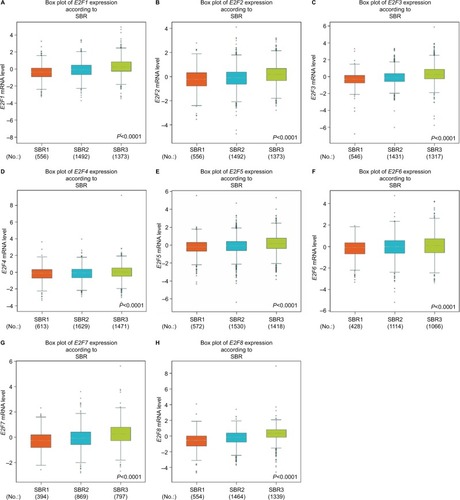
We found that ER status was negatively associated with mRNA levels of E2Fs except for E2F6, whereas PR status was negatively associated with mRNA levels of E2Fs except for E2F5. In HER2-positive groups of BC patients, the transcription levels of E2F1, E2F3, E2F7, and E2F8 were significantly up-regulated compared with HER2-negative groups. As mentioned before, TNBC is a special type of BC with negative ER, PR, and HER2, and has the worst clinical outcome. The mRNA levels of E2Fs, except for E2F4 and E2F6, were found to be significantly higher in TNBC patients ().
BC patients with alterations of E2Fs have poorer OS
Among the overall 2,509 patients with breast invasive carcinoma in the selected dataset, 1,120 (44.6%) were detected to have alterations of E2Fs (). E2F5 was altered in 22% of BC patients in this dataset. BC patients with alterations of E2Fs were found to have significantly poorer OS according to analyses by log-rank tests in the Kaplan–Meier survival plots (P=0.0249) ().
Figure 2 Analysis of E2Fs’ alterations in breast invasive carcinoma (using cBioPortal for Cancer GenomicsCitation21,Citation22).
Notes: (A) The Kaplan–Meier plot comparing overall survival of breast carcinoma patients with E2F alterations (n=1,120) and without E2F alternations (n=1,389). (B) Oncoprint in cBioPortal represented the proportion and distribution of cases with E2F alterations. The figure was cropped on the right to exclude cases without alterations.
Abbreviation: E2Fs, E2F transcription factors.
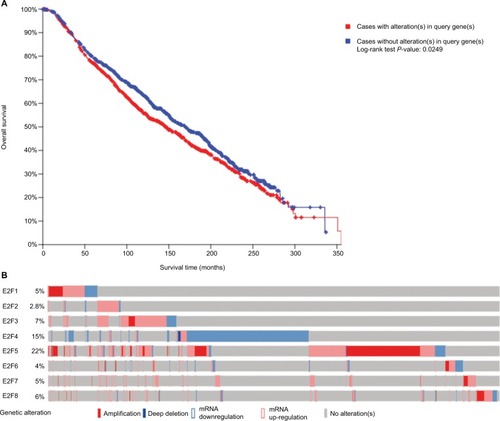
Higher mRNA levels of E2F1, E2F3, and E2F8 were associated with poorer OS and RFS of BC patients
It was found that mRNA levels of E2F1, E2F3, and E2F8 were significantly correlated with OS and RFS in all BC patients (P<0.05) ( and ), through analyses by log-rank tests in the Kaplan–Meier survival plots. Higher mRNA levels of E2F1, E2F3, and E2F8 predicted poorer OS and RFS in BC patients. In contrast, BC patients with higher mRNA levels of E2F4 were found to have better RFS. Additionally, transcription levels of E2F7 were negatively associated with RFS but not OS in BC patients.
Figure 3 The prognostic value of mRNA levels of E2Fs in BC patients (OS in Kaplan–Meier Plotter).
Notes: (A) E2F1 (204947_at). (B) E2F2 (228361_at). (C) E2F3 (203693_s_at). (D) E2F4 (202248_at). (E) E2F5 (221586_s_at). (F) E2F6 (203957_at). (G) E2F7 (228033_at). (H) E2F8 (219990_at).
Abbreviations: E2Fs, E2F transcription factors; BC, breast carcinoma; OS, overall survival.
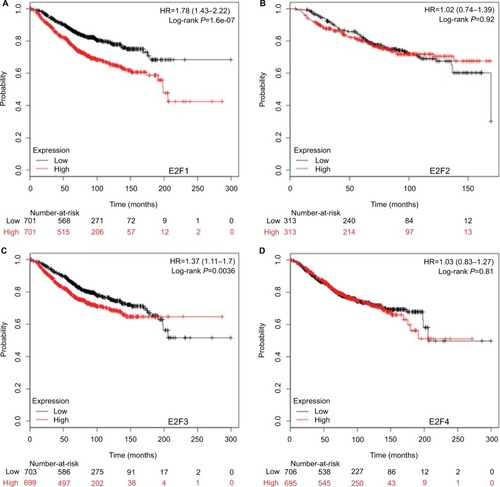
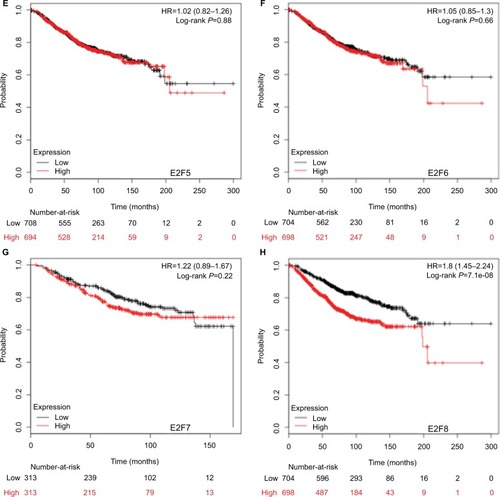
Figure 4 The prognostic value of mRNA levels of E2Fs in BC patients (RFS in Kaplan–Meier Plotter).
Notes: (A) E2F1 (204947_at). (B) E2F2 (228361_at). (C) E2F3 (203693_s_at). (D) E2F4 (202248_at). (E) E2F5 (221586_s_at). (F) E2F6 (203957_at). (G) E2F7 (228033_at). (H) E2F8 (219990_at).
Abbreviations: E2Fs, E2F transcription factors; BC, breast carcinoma; RFS, relapse-free survival.
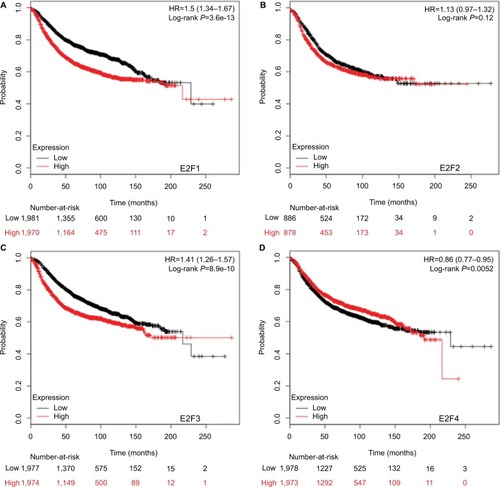
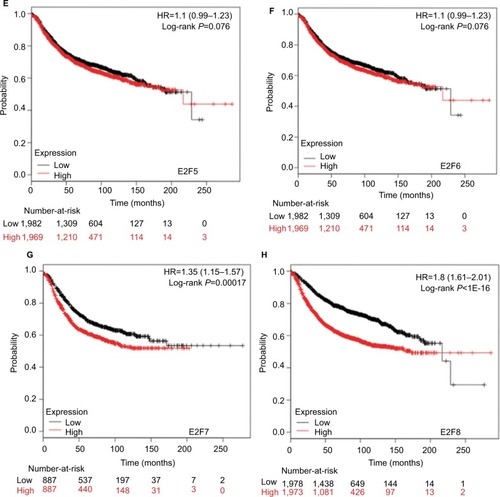
Discussion
The E2Fs were involved in BC development and metastasis, and demonstrated prognostic values according to currently available limited studies. However, the multifaceted roles of E2Fs in the development, metastasis, and prognostication of BC remain to be clarified. As far as we know, this is the first study that systematically analyzed the mRNA expression levels and prognostic values of the eight E2Fs in human BC.
E2F1, the first member of the family of E2Fs, was proven to initiate and maintain tumors originating from distinct tissues in multiple mouse models.Citation29 However, some studies demonstrated that they induced cell apoptosis and resulted in inhibition of tumor growth in some specific tissue types, such as the skin.Citation29 As for BC, Wu et al found that E2F1 played an oncogenic role in ErbB2- or Myc-triggered mam mary tumorigenesis.Citation30 Moreover, the low transcription level of E2F1 was reported as a strong determinant of favorable outcome for BC patients.Citation31 In this study, we found that the mRNA level of E2F1 was significantly up-regulated in BC. Higher mRNA level of E2F1 was associated with higher SBR grade and TNBC, which predicted higher degree of malignancy, higher incidence of recurrence and metastasis, and worse clinical outcomes. In survival analysis, BC patients with higher mRNA level of E2F1 were found to have poorer OS and RFS. We thus suppose E2F1 as a target for precision therapy of BC patients, and a previous study in cell lines found that MIR372 inhibited proliferation and induced apoptosis in BC cells by directly targeting E2F1.Citation32
Significant reductions in tumor incidence, the metastatic capacity of the tumor and the number of circulating tumor cells in animals with E2F2 knockout background were found in numerous studies.Citation2,Citation33 E2F2 loss resulted in increased metastasis of BC, potentially functioning through a PTPRD-dependent mechanism.Citation22 Interestingly, on the contrary, Wu et al noted a tumor suppressor role of E2F2 in Myc-mediated mammary tumorigenesis.Citation30 The mRNA level of E2F2 was found to be significantly higher in BC, especially in TNBC, and it was positively associated with the SBR grade as E2F1. However, unlike E2F1, mRNA expression level of E2F2 did not have prognostic values for OS or RFS of BC patients. Nguyen-Vu et al reported that LXR ligand treatment downregulated transcription level of E2F2 and resulted in significant disruption of cell proliferation in ER-positive BC.Citation34 This finding supported that E2F2 might also be a potential treatment target for BC. Considering the small number of studies focused on functions of E2F in BC, more work needs to be carried out in future.
The oncogenic activity of E2F3 has been observed in ErbB2- or Myc-triggered mammary tumorigenesis.Citation30 Fujiwara et al noted a significant reduction in tumor incidence with the loss of E2F3,Citation33 whereas Lee et al found that E2F3 silencing inhibited mammary tumor growth through reducing the percentage of cells undergoing mitosis.Citation35 An in vitro study demonstrated that E2F3 was a diagnostic and potential therapeutic target in BC.Citation36 In this study, the mRNA level of E2F3 was found to be significantly higher in BC. Higher mRNA level of E2F3 was associated with higher SBR grade and TNBC. Survival analysis revealed that higher mRNA levels of E2F3 predicted poorer OS and RFS in BC patients, and we thus suppose E2F3 as another therapeutic target for BC patients. A previous study found that metformin reduced the incidence of breast cancer and metastasis by increasing miR-26a expression, which downregulated the expression level of E2F3.Citation37 Another in vitro study reported that T-VISA-miR-34a induced expression of miR-34a, and dramatically suppressed growth, migration, and invasion of breast cancer cells by downregulating the protein expression levels of target genes including E2F3.Citation38 Vimala et al found that siRNA for E2F3 facilitated the silencing of E2F3 overexpression and “fought against” BC in cell lines.Citation36 Results of these studies are consistent with our assumption.
It was reported that E2F4 had an oncogenic role rather than a tumor suppressor role in breast carcinogenesis, and expression of E2F4 in invasive BC was associated with poor prognosis.Citation39 Although there was no significant up-regulation or downregulation of E2F4 expression level in BC, BC patients with higher mRNA levels of E2F4 were found to have significantly better RFS. We thus supposed that E2F4 was a potential prognostic marker for better survival of BC patients. Considering the currently available little evidence and the unavoidable limitations of this study, further research needs to be performed to investigate the role of E2F4 in BC.
Polanowska et al found that E2F5 was oncogenic in primary rodent cells and was amplified in human BC,Citation10 whereas Umemura et al found that E2F5-positive subtype of BC was associated with a basal phenotype, TNBC, and worse clinical outcome.Citation11 In this study, it was found that the mRNA level of E2F5 was significantly higher in BC. Higher mRNA level of E2F5 was correlated with higher SBR grade and TNBC. BC patients with positive nodal status showed significantly higher mRNA level of E2F5 than negative nodal patients. This finding supported that E2F5 might play a role in lymph node metastasis of BC patients. Through targeting E2F5 with miR-154 in cell lines, the growth and invasion of breast cancer cells were inhibited.Citation40 However, mRNA expression levels of E2F5 did not have prognostic values in BC patients according to our study.
Several current studies found that E2F6 negatively regulated BRCA1 in BC.Citation12,Citation13 The mRNA level of E2F6 was found to be significantly higher in BC, and higher mRNA level was found in higher SBR grade of BC patients, which indicated worse clinical outcomes. However, no significant difference of OS or RFS was found between BC patients with high and low mRNA level of E2F6. As little research has focused on E2F6 so far, the underlying role of E2F6 in BC needs more investigation.
E2F7 and E2F8 were both supposed to promote tumorigenicity in breast cancer according to currently available limited studies.Citation14,Citation15 We found that both of their transcription levels were significantly higher in BC. BC patients with higher SBR grade and TNBC patients had higher mRNA levels of E2F7 and E2F8. Not surprisingly, the transcription levels of E2F7 and E2F8 were negatively associated with RFS of BC patients. Higher E2F8 expression level also predicted worse OS of BC patients. These results indicate that E2F7 and E2F8 are both potential new targets for individualized treatments of BC patients, and further studies need to be performed to explore their potential values.
We also found that alterations of E2Fs were frequent genetic events in BC patients and BC patients with alterations of E2Fs appeared to have significantly poorer OS, although the underlying mechanism is still unclear.
Conclusion
We performed comprehensive analyses on the expressions and prognostic values of the eight E2Fs in BC in this study, for the first time, to provide a better understanding of the diversity of BC regarding various aspects including clinical, histopathological, and biomolecular characteristics. Our results indicate that E2F1, E2F3, E2F7, and E2F8 are potential targets for individualized treatment of BC patients, whereas E2F4 is a potential prognostic marker for better survival of BC patients.
Acknowledgments
This work was supported by the National Natural Science Foundation of China (nos. 81071950, 81301903).
Disclosure
The authors report no conflicts of interest in this work.
References
- DegregoriJJohnsonDGDistinct and Overlapping Roles for E2F Family Members in Transcription, Proliferation and ApoptosisCurr Mol Med20066773974817100600
- HollernDPHoneysettJCardiffRDAndrechekERThe E2F transcription factors regulate tumor development and metastasis in a mouse model of metastatic breast cancerMol Cell Biol201434173229324324934442
- AndrechekERHER2/Neu tumorigenesis and metastasis is regulated by E2F activator transcription factorsOncogene201534221722524362522
- AttwoollCLazzerini DenchiEHelinKThe E2F family: specific functions and overlapping interestsEmbo J200423244709471615538380
- TorreLABrayFSiegelRLGlobal cancer statistics, 2012CA Cancer J Clin20156528710825651787
- OnitiloAAEngelJMGreenleeRTMukeshBNBreast cancer subtypes based on ER/PR and Her2 expression: comparison of clinicopathologic features and survivalClin Med Res200971–241319574486
- VerlindenLvanden BemptIEelenGThe E2F-regulated gene Chk1 is highly expressed in triple-negative estrogen receptor/progesterone receptor/HER-2 breast carcinomasCancer Res200767146574658117638866
- JohnsonJThijssenBMcdermottUTargeting the RB-E2F pathway in breast cancerOncogene201635374829483526923330
- ChenHZTsaiSYLeoneGEmerging roles of E2Fs in cancer: an exit from cell cycle controlNat Rev Cancer200991178579719851314
- PolanowskaJLe CamLOrsettiBHuman E2F5 gene is oncogenic in primary rodent cells and is amplified in human breast tumorsGenes Chromosomes Cancer200028112613010738311
- UmemuraSShiraneMTakekoshiSOverexpression of E2F-5 correlates with a pathological basal phenotype and a worse clinical outcomeBr J Cancer2009100576477119259095
- OberleyMJInmanDRFarnhamPJE2F6 negatively regulates BRCA1 in human cancer cells without methylation of histone H3 on lysine 9J Biol Chem200327843424664247612909625
- YangWWWangZHZhuYYangHTE2F6 negatively regulates ultraviolet-induced apoptosis via modulation of BRCA1Cell Death Differ200714480781717096023
- ChuJZhuYLiuYE2F7 overexpression leads to tamoxifen resistance in breast cancer cells by competing with E2F1 at miR-15a/16 promoterOncotarget2015631319443195726397135
- YeLGuoLHeZUpregulation of E2F8 promotes cell proliferation and tumorigenicity in breast cancer by modulating G1/S phase transitionOncotarget20167172375726992224
- SealfonSCChuTTRNA and DNA microarraysMethods Mol Biol201167167133420967621
- RhodesDRYuJShankerKONCOMINE: a cancer microarray database and integrated data-mining platformNeoplasia2004611615068665
- RestJSWilkinsOYuanWPuruggananMDGurevitchJMeta-analysis and meta-regression of transcriptomic responses to water stress in ArabidopsisPlant J201685454856026756945
- JézéquelPCamponeMGouraudWbc-GenExMiner: an easy-to-use online platform for gene prognostic analyses in breast cancerBreast Cancer Res Treat2012131376577521452023
- JézéquelPFrénelJSCampionLbc-GenExMiner 30: new mining module computes breast cancer gene expression correlation analysesDatabase (Oxford)20132013bas06023325629
- GaoJAksoyBADogrusozUIntegrative analysis of complex cancer genomics and clinical profiles using the cBioPortalSci Signal20136269pl123550210
- CeramiEGaoJDogrusozUThe cBio cancer genomics portal: an open platform for exploring multidimensional cancer genomics dataCancer Discov20122540140422588877
- PereiraBChinSFRuedaOMThe somatic mutation profiles of 2,433 breast cancers refines their genomic and transcriptomic landscapesNat Commun201671147927161491
- GyőrffyBSurowiakPBudcziesJLánczkyAOnline survival analysis software to assess the prognostic value of biomarkers using transcriptomic data in non-small-cell lung cancerPLoS One2013812e8224124367507
- GyörffyBLanczkyAEklundACAn online survival analysis tool to rapidly assess the effect of 22,277 genes on breast cancer prognosis using microarray data of 1,809 patientsBreast Cancer Res Treat2010123372573120020197
- LánczkyANagyÁBottaiGmiRpower: a web-tool to validate survival-associated miRNAs utilizing expression data from 2178 breast cancer patientsBreast Cancer Res Treat2016160343944627744485
- LiQBirkbakNJGyorffyBSzallasiZEklundACJetset: selecting the optimal microarray probe set to represent a geneBMC Bioinformatics201112147447722172014
- CurtisCShahSPChinSFThe genomic and transcriptomic architecture of 2,000 breast tumours reveals novel subgroupsNature2012486740334635222522925
- LeeMRivera-RiveraYMorenoCSSaavedraHIThe E2F activators control multiple mitotic regulators and maintain genomic integrity through Sgo1 and BubR1Oncotarget20178447764929100415
- WuLde BruinAWangHSelective roles of E2Fs for ErbB2- and Myc-mediated mammary tumorigenesisOncogene201534111912824276244
- VuaroqueauxVUrbanPLabuhnMLow E2F1 transcript levels are a strong determinant of favorable breast cancer outcomeBreast Cancer Res200793R3317535433
- ZhaoYXLiuHCYingWYmicroRNA372 inhibits proliferation and induces apoptosis in human breast cancer cells by directly targeting E2F1Mol Med Rep20171668069807528944922
- FujiwaraKYuwanitaIHollernDPPrediction and genetic demonstration of a role for activator E2Fs in Myc-induced tumorsCancer Res20117151924193221245101
- Nguyen-VuTVedinLLLiuKLiver × receptor ligands disrupt breast cancer cell proliferation through an E2F-mediated mechanismBreast Cancer Res2013153R5123809258
- LeeMOprea-IliesGSaavedraHISilencing of E2F3 suppresses tumor growth of Her2+ breast cancer cells by restricting mitosisOncotarget2015635373163733426512919
- VimalaKSundarrajSSujithaMVKannanSCurtailing overexpression of E2F3 in breast cancer using siRNA (E2F3)-based gene silencingArch Med Res201243641542222960857
- CabelloPPinedaBTormoELluchAErolesPThe Antitumor Effect of Metformin Is Mediated by miR-26a in Breast CancerInt J Mol Sci20161781298
- LiLXieXLuoJTargeted expression of miR-34a using the T-VISA system suppresses breast cancer cell growth and invasionMol Ther201220122326233423032974
- RakhaEAPinderSEPaishECRobertsonJFEllisIOExpression of E2F-4 in invasive breast carcinomas is associated with poor prognosisJ Pathol2004203375476115221934
- XuHFeiDZongSFanZMicroRNA-154 inhibits growth and invasion of breast cancer cells through targeting E2F5Am J Transl Res2016862620263027398145
